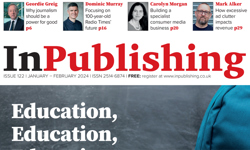
“In my beginning, is my end. In succession, houses rise and fall... Are removed, destroyed, restored, or in their place is an open field, or a factory, or a bypass. Old stone to new building, old timber to new fires. Old fires to ashes, and ashes to the earth.”
So begins TS Eliot’s East Coker, the second of his Four Quartets series of works, first published in 1940.
It’s a poem that has fascinated me with its imagery and meaning since I first read it as a teenager in 1989. While the world Eliot inhabited some 80 years ago was obviously very different to the world we find ourselves in today, the messages he conveys – change, inevitability, disorder, repetition, hope – are as relevant now as they were then, as we struggle to negotiate our way through a rapidly evolving, disruptive landscape in the midst of political upheaval.
Those themes are also very relevant to the world of digital publishing.
First up, change and inevitability.
We live in a media landscape that continues to change. A landscape where it’s becoming harder to make money. One where agile methodologies and extensions to traditional print brands (ecommerce, data, events) will be successful.
Change is now upon us constantly. Nothing stays the same for long, not like it used to in the 1990s glory days of publishing. Before you reach the end of a project, it’s likely the product it delivers will soon be out of date or superseded by something else.
Tech changes are never-ending and inevitable. Smart phones are more powerful than ever: it won’t be long before virtually indestructible, foldable screens (utilising graphene technology) become cheap enough to manufacture en masse.
And that will likely be a game changer, because, feasibly, you could have a phone that turns into a tablet via an unwinding, scrollable screen, creating an amalgamation of the two devices. The end of the iPad? Or the beginning of the iPad replacing the laptop? Who knows. But we know change is always coming, replacing what went just before.
Old timber to new fires. It’s inevitable.
Secondly, disorder. Or, to use a more modern term, ‘disruptor’.
The very people that once helped build our brands – our contributors, our writers – are now among our biggest competitors. I went fishing with an Angling Times columnist a few weeks back. A 59-year-old man with no historic skill in the digital arena.
“I used to rely on Angling Times for my writing,” he told me, “to give me a platform. These days, I don’t need it. I broadcast live on Facebook and have my own website and blog. I can reach more people with my content that way.”
The print magazine I used to be editor of achieved a newsstand circulation every issue of around 23,000 copies when I was at the helm. Not bad for a specialist title. Now one of its contributors – a man whose media career I launched – has a combined Twitter, Facebook and Insta following approaching 100,000 people.
The point is, he alone is arguably now more influential than ‘my’ magazine ever was, because he can reach more eyeballs, and because his influence can be attributed in a way his print articles never could be. The influence of digital is clear. Of print, it is always ever only opaque.
But all this is not to say there isn’t hope. Because, let me assure you, there is. So thirdly, let’s look at hope.
People will always want content. Just how they want it delivered to them changes. I still believe that there is a market for print magazines and digital app offshoots that complement. I’m convinced of it, especially for specialist titles. And especially if you can build a high-yield magazine subscriptions business via your own ecommerce platform that gives you data and a direct relationship with the customer.
This way, you get stability in your business model. You know who the readers are, you know what they like. You know how many copies you have to print and what the cost will be of producing them and sending them out every week, or month.
Print newsstand sales will become secondary. A support act for the main platform, which is yours. Get it right and you’ll no longer need to worry quite so much if Tesco removes your title from 80 of its stores. Or if WHSmith goes bust.
In harmony with this, you’ll have your website – and importantly, a digital edition app that gives people their daily engagement with the brand on their mobile devices, connecting them every day with the content they love; showcasing enhanced interactive features such as video, puzzles, podcasts and daily news. A proposition your principle competitors cannot provide.
People still enjoy reading paper. They like the familiarity of it, the anticipated repetition of a magazine dropping through their letter box each week or month. So, there is always hope, as long as you can stay one step ahead and deliver something people want to read.
TS Eliot was also obsessed with finality: the end of an object, a person, a relationship or a time. Thus, I can announce that this piece marks the last of my regular columns in InPublishing, which have now been running for over four years.
In my first article, I asked this question: How do we make it clear that while times are difficult, they’re also incredible exciting, as there is real opportunity out there?
Despite the undoubted progress we’ve made in our products over the last four years – and despite the growing operating profit my colleagues and I have delivered Mr & Mrs Bauer year-on-year – that question is as relevant now as it was in the summer of 2014.
And it always will be relevant.
Times change, yet remain the same. In my beginning is my end.










